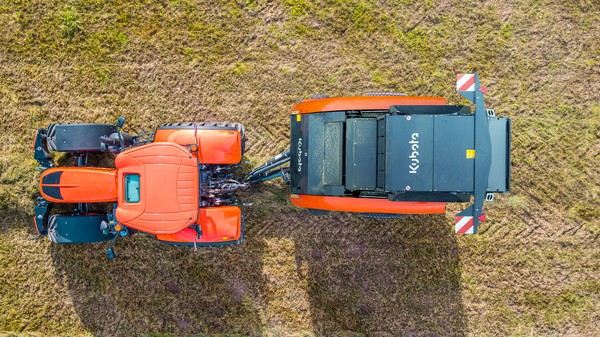
Kubota's "smart" round balers
Among the first companies to use the Tractor Implement Management (TIM) system, Kubota has made a technological leap with the introduction of the TIM Pack 2.0 on its new generation of variable chamber round balers: the BV6000. The series, winner of the Technical Innovation competition at EIMA 2024, is being presented at the Bologna event and is available in two models: the BV6160 and BV6190, capable of producing bales with a diameter of 1.65 and 1.85 meters, respectively. TIM Pack 2.0 technology introduces two significant innovations. The first, the Auto Feed Control, is a hydraulic oscillating drawbar that receives the oil flow from a distributor controlled by the tractor and which allows the baler to be moved both to the left and to the right. The system is completely autonomous and processes information coming from sensors located on the sides of the machine, in order to operate directly on the swath. In this way the equipment is able to produce a bale with the right density and shape, avoiding soil contamination, since the tractor wheels remain far from the forage. The second innovation is an additional device, called Auto Blockage Control, which monitors the crop flow passing through the baler's packer, reacting in real time in the event of crop build-up or rotor blockage.
The bales are produced by a pick-up with a working width of 2.3 meters with double transmission, which improves the reliability and maneuverability of the round baler. The PowerFeed rotor and ChopFeed knife packers, which are distinguished by their larger dimensions (the diameter is 520 mm), are equipped with the DropFloor parallelogram anti-clogging system. Also new is the intelligent four-belt hydraulic density system, which ensures heavier bales for all crop types.
Another plus of the BV6000 round balers is the PowerBind technology - one of the lowest bale loading systems on the market - which allows for uniform netting, reduced short binding cycles and the production of regularly shaped bales. Vertical storage of replacement rolls reduces waste build-up, while a fold-down device makes it easier to handle heavier rolls. During the design phase, the technicians of the Research and Development and Assistance departments of the Japanese company managed to cut the machine's maintenance times by 60% thanks to an improvement in the design, a rationalization of the access points of the round baler and the introduction of optional functions (such as automatic greasing) which led to lower accumulation of residues.








